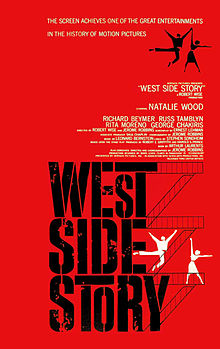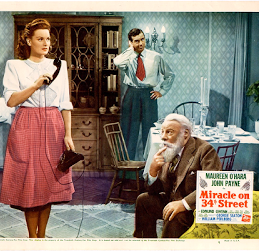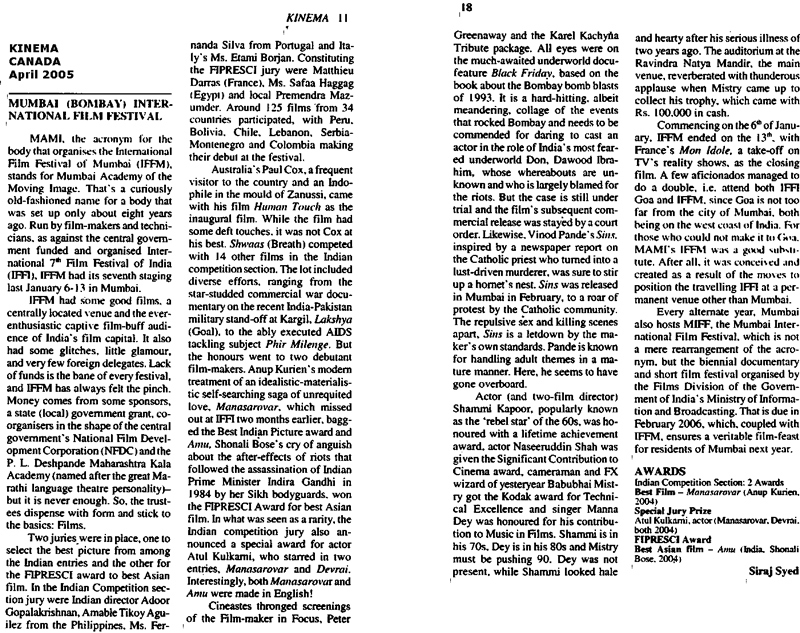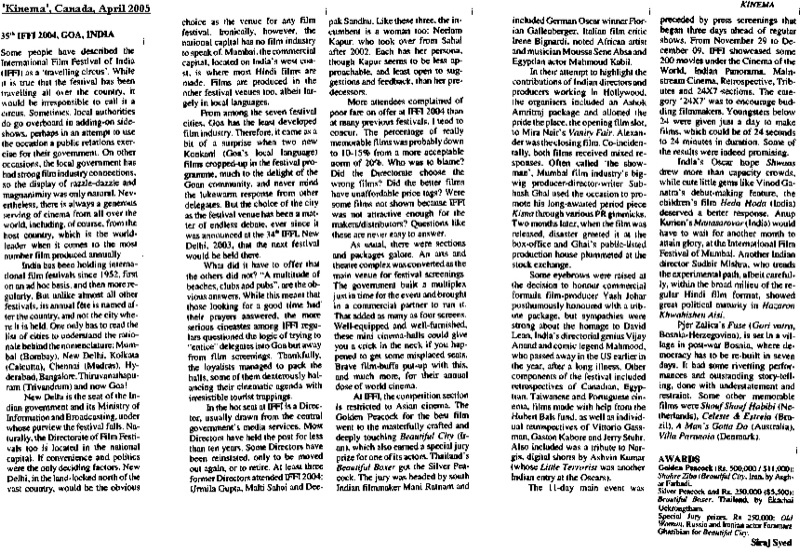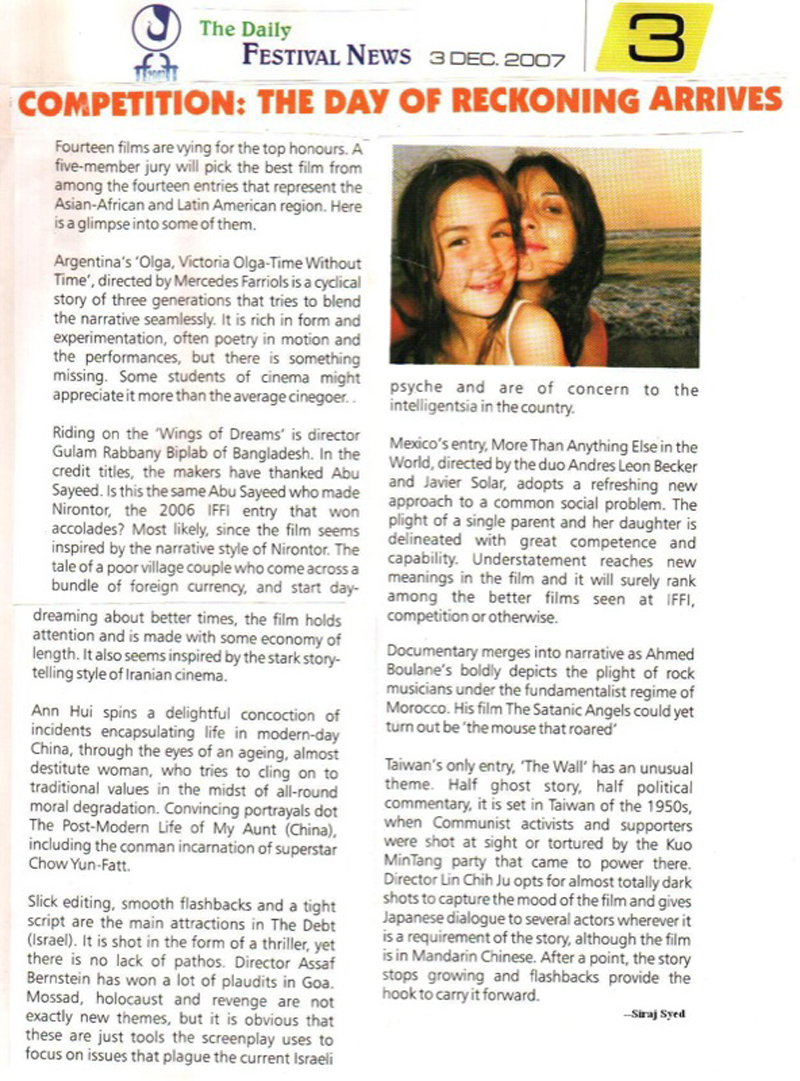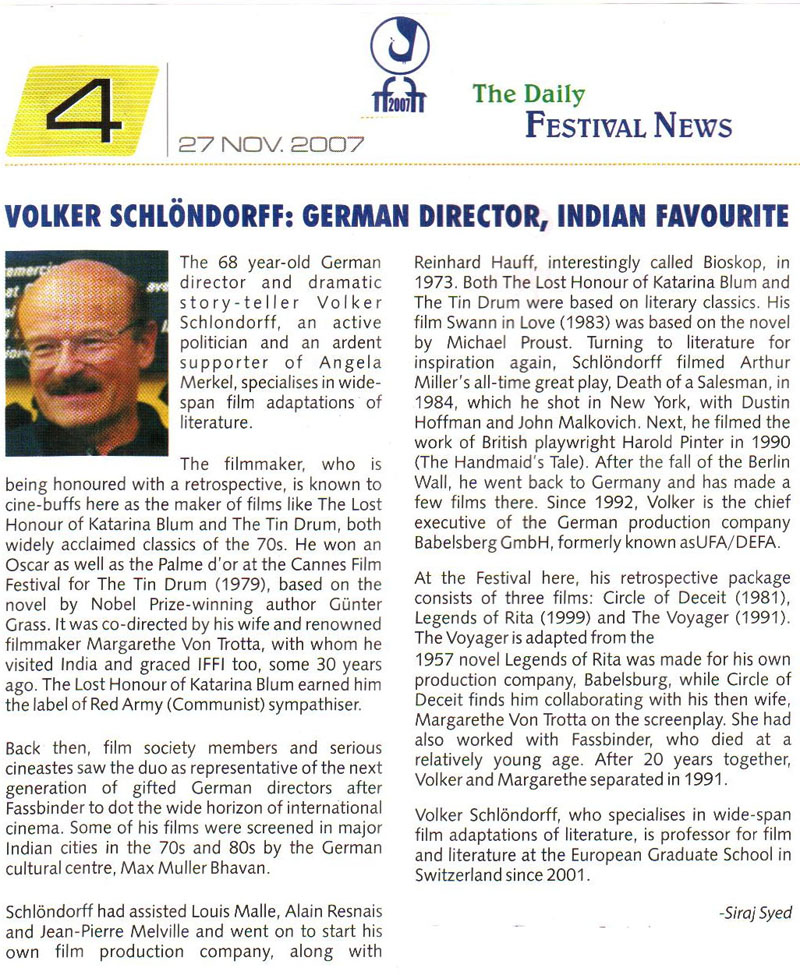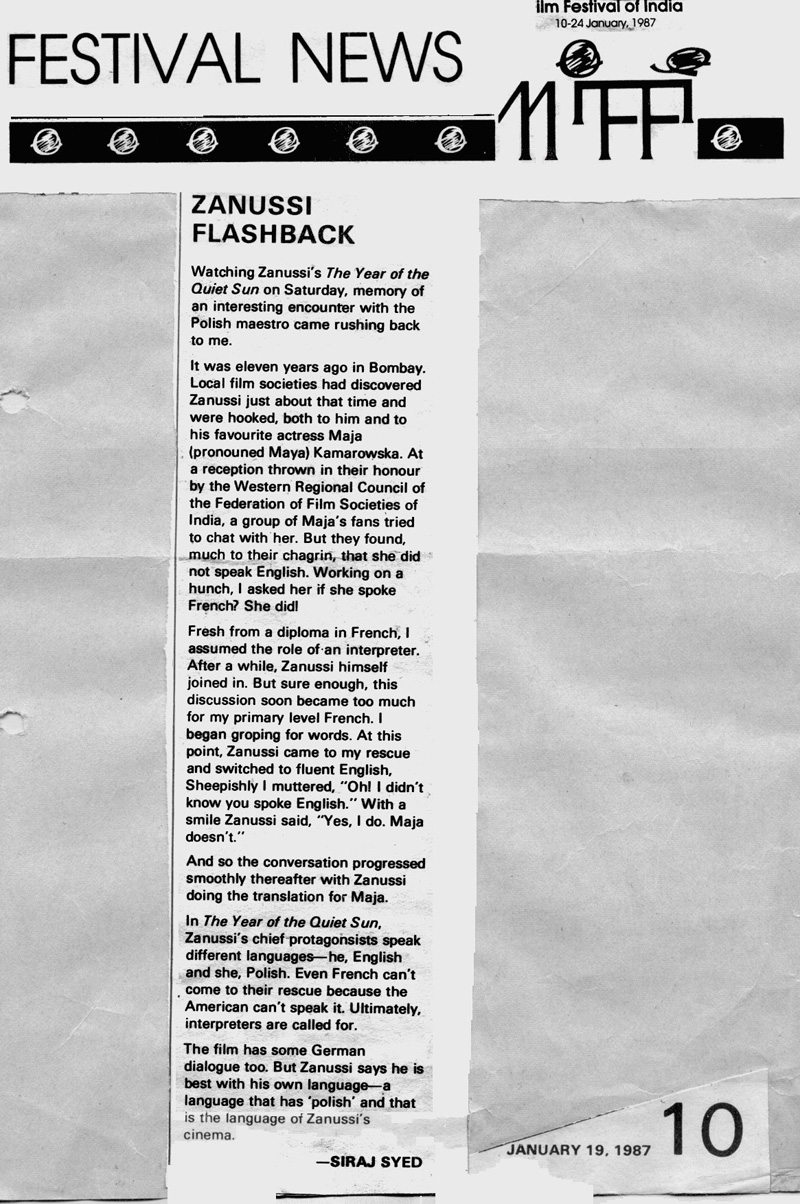|
|
||
|
Pro Tools
FILMFESTIVALS | 24/7 world wide coverageWelcome ! Enjoy the best of both worlds: Film & Festival News, exploring the best of the film festivals community. Launched in 1995, relentlessly connecting films to festivals, documenting and promoting festivals worldwide. We are sorry for this ongoing disruption. We are working on it. Please Do Not Publish until this message disappears. For collaboration, editorial contributions, or publicity, please send us an email here. User login |
Siraj SyedSiraj Syed is the India Correspondent for FilmFestivals.com and a member of FIPRESCI, the International Federation of Film Critics. He is a Film Festival Correspondent since 1976, Film-critic since 1969 and a Feature-writer since 1970. He is also an acting and dialogue coach. @SirajHSyed  Siraj Syed’s IFFI 2016 diary, V: And the Oscar for restoring classics goes to…AMPAS!
Siraj Syed’s IFFI 2016 diary, V: And the Oscar for restoring classics goes to…AMPAS! American body Academy of Motion Picture Arts and Sciences (AMPAS) is best known for presenting the annual awards, which are characterised by a figurine called the Oscar. Though that is the face of the academy, it does much more service to the cause of both American and international cinema than most people would imagine, including holding an annual student Oscars. At the Black Box of Panaji’s Kala Academy, AMPAS’s inventory film archivist/short film preservationist Tessa Idlewine, who holds a degree in film archiving and restoration, revealed the extraordinary effort that the academy puts into film storage and restoration, and the pain-staking 20 years it took to restore Indian idol Satayjit Ray’s work. “It’s an on-going exercise that began with the shocking realisation that the academy did not have clips of serviceable quality to go with the audio-visual which was to precede the conferment of the Oscar on Ray, while he would address the gathering via video-link from his hospital bed in Kolkata. The results include the amazing restoration of almost all of his films, the most decorated of which, Pather Panchali, is being shown on Friday at IFFI Goa 2016,” she said. AMPAS is among the three major film preservation and restoration centres in the USA, the National Archive and the Library of Congress being the other two . During the 1890s-1950s nitrate base was used to make film, and nitrate burns even without oxygen, so many of the titles perished. Even later, after acetate (vinegar-base) came in, the negatives corroded, mainly due to the vinegar (spilled acidic liquid) effect. So, only 20% of films could make it through, from the period 1910-20, and 50% from 1921-1950. Polyester, in use after 1990, is much more durable. Digital is the current rage, but we do not know how long-lasting it will be,” she added. Incidentally, Tessa’s range of duties spans film handling, film identification, preservation, conservation, cataloguing, film archiving ethics, curating, customer service skills, copy- editing, materials management, transcription, typing (70 WPM), and word processing.
Besides the Ray collection, to the restoration of which laboratory Cineteca, in Bolognia, Italy, made the most significant contribution, AMPAS already has 5,500 titles, weighing 1mn lbs/450,000 kg of film, in 8 mm, Super 8 mm, 9.5 mm (who knew about this?), 16 mm, 28 mm (rare indeed!) and the obvious gauge of 35 mm and 70 mm, stored in ideal conditions. Besides, 124 interviews have been recorded, including one with Sharmila Tagore, the yester-years’ Hindi and Bengali film-star, and former Chairperson of the Central Board of Film Certification (CBFC). Informal archiving has been going on since the first Oscars, 1928-29 (audio) and formal work started in 1948-49 (audio-visual). Over the years, they have restored films like WestSide Story, Miracle on 34th Street, Oliver and Heaven Can Wait. Archival Revival--25 Years of The Academy Film Archive, was launched last year, in July, and ran through September, with the Robert Wise and Jerome Robbins-directed classic, West Side Story, flagging it off. And if subsequent programs are anywhere near the quality of the 70MM and 6-track stereo sound restored film print, shown at the Academy’s Samuel Goldwyn Theatre,
Miracle was first shown in its restored version on Thursday, December 11, 2015, at the Samuel Goldwyn Theater, in Beverly Hills. The 35mm print was from the collection of the Academy Film Archive, courtesy of Twentieth Century Fox, and was presented as part of the Academy’s Gold Standard screening series. Made in 1947, the film was written and directed by George Seaton, and stars Maureen O’Hara as the cynical Macy’s executive whose equally sceptical eight-year-old daughter (Natalie Wood) is intrigued by the store’s seasonal Santa Claus, who may or may not be the real thing. Miracle on 34th Street won Academy Awards for Actor in a Supporting Role (Edmund Gwenn), Writing--Motion Picture Story (Valentine Davies) and Writing--Screenplay (Seaton) and earned a nomination for Best Motion Picture (20th Century-Fox). Its lead actress, Maureen O’Hara died in October last year. Shivendra Dungarpur, who is the Founder-Director of the Film Heritage Foundation (Mumbai) and who made a rivetting documentary on P.K. Nair, the late Director of the National Film Archive of India (Pune), introduced Idlewine and conducted the Q&A session afterwards. He recalled Ray’s legendary cameraman Subroto Mitra wondering whether future generations would be able to appreciate his work with Ray, given the sorry quality of existing prints and VHS tapes that were being used to copy films, those days. “He should have been alive today to see the remarkable restoration made possible by the resources and perseverance of a dedicated few,” wished Dungarpur. He has collaborated on two world-class restoration projects with Martin Scorsese’s World Cinema Foundation: Uday Shankar’s classic film ‘Kalpana’ and eminent Sri Lankan filmmaker Dr. Lester James Peries film ‘Nidhanaya’ that premiered at the Cannes Film Festival in 2012 and Venice Film Festival 2013 respectively. He was a donor for the restoration of Hitchcock’s silent film ‘The Lodger’ that was done by the British Film Institute. Shivendra travels the world to meet and extensively interview great masters of cinema for his personal.
Present in audience was Mr. Sid Ganis, Former President of Academy of Motion Picture Arts and Sciences (AMPAS) and American Motion Picture Executive and Producer. Mr. Sid Ganis had a distinguished career in Hollywood as an executive at major studios, including Sony Pictures, Lucasfilm, Warner Bros. and Paramount, and produced films such as Big Daddy, Deuce Bigalow, Mr. Deeds, The Master of Disguise and Akeelah and the Bee. He is a longtime member of the Academy of AMPAS, for which he served four consecutive year-long terms as president, from 2004-2009. At 77, he has had a long and illustrious career. At a press conference held later, Ganis said that the Academy has been developing a very close relationship with the Indian film-makers, and with Goa, through the International Film Festival of India. In the past few years, the Academy is getting to know Indian celebrities and film-makers and wanting to enhance and expand their relationship with Indian Film Industry. He further added that the Academy is not just an Academy for America or Hollywood alone, but about film-makers and artists across the world. At the 47th IFFI, Mr. Ganis conducted a special workshop on 'Foreign Language Film Selection for Oscar Awards by AMPAS’.
At the same, joint conference, Idlewine described about the criteria, how a film is being selected for preserving, saying that, firstly, preference is given to the Oscar-nominated films, but that is not all. Apart from the Oscar nominated films, the ones, which are unique, important, and decaying, are also preserved. Out of the 37 films under the project, 21 have been restored successfully. Commenting over the preservation of the work of Satyajit Ray, Tessa said that the AMPAS is working continuously to save the artistic works of the maestro. India’s Top 10 Lost Films – Compiled by late P.K. Nair, the Director and the moving force behind National Film Archive of India (NFAI). (Thanks to Shivendra Dungarpur for the information) Bhakta Vidur (Alternate Title: Dharma Vijay), 1921, 89 mins Adopting the perspective of Vidur- the chief advisor to the Kauravas, who, for ethical reasons, sided with the Pandavas prior to the great war of Kurukshetra- the film ‘Bhakta Vidur’ sought to hold a moral lens to the struggle between British colonialists and the Indian resistance. Bilet pherat (Alternate title: England returned),1921, 68mins One of the earliest examples of broad, deliberate satire made in the mould of the Hollywood slapstick comedies of the time, ‘Bilet Pherat’ (1921) lampoons the trend of Indians travelling abroad (in those days, usually to Britain) for higher education in a… Savkari Pash (The Indian Shylock), 1925, 80 mins A milestone film by Baburao Painter, ‘Savkari Pash’ is notable not just for its courage in going against the grain but also for its technical finesse and poignant treatment of its subject matter. At a time when mythological films were de rigueur, Baburao Painter staked almost everything to make India’s first social realist film. Balidan (Sacrifice), 1927, 108 mins ‘An excellent and truly Indian film’- The Indian Cinematograph Committee, 1927. ‘Balidan’ was a persuasive effort at bringing about social reform with its story of a conflict between a progressive, rational king and an orthodox, ritual-bound priest. Alam Ara (1931) Hindi/ Urdu, 124 mins ‘Alam Ara’ occupies its position in Indian film history as the first film to have employed sound and possess a diegetic soundtrack, complete with songs. A swashbuckling tale of warring queens, palace intrigue, jealousy and romance, the film was heavily drawn from Parsee theatre The first Indian film to have been made in colour, (though not indigenously since it was processed and printed in Babelsburg, Germany using the Agfacolor process), ‘Sairandhri’ is a remake of Baburao Painter’s silent classic from 1920, of the same name Mill (Mazdoor), 1934, 142 mins This is the only film written by the acclaimed writer Munshi Premchand in which he also played a cameo. The film courted controversy owing to its story of a prodigal son of a benevolent mill worker who inherits the mill and proceeds to treat its workers with disdain. A mythological film with a stellar cast featuring Prithviraj Kapoor as Ram and Durga Khote as Seeta along with some of the most high-profile actors of the time, the film broke new ground by becoming the first Indian film to gain international exposure: it was screened at the 1934 Venice Film Festival where Debaki Bose won an award, the first Indian filmmaker to do so on an international platform. Zindagi (Life), 1940, 120 mins One of the highest grossing films of the 1940s, the music for the film was composed by Pankaj Mullick. The film saw P.C. Barua coming together once again with K.L. Saigal along with the actress Jamuna. It was a film that not only challenged social mores but also explored the complexities and consequent disillusionment of an unusual platonic relationship between an unmarried couple living together. Khoon ka Khoon (Hamlet), 1935, 122 mins This was the first adaptation of a Shakespearan drama in Indian cinema. Largely a filmed version of a stage performance of the play, the film contains a towering performance by Sohrab Modi in the central role of Hamlet, and is an astute adaptation of the original Shakespeare play. The film marked the feature debut of Naseem Banu, as Ophelia. Meanwhile, AMPAS is at it all the time, with four goal-posts: Conservation, Preservation, Restoration, Access. Primarily of American Oscar-winners, and, more significantly for world cinema, any film it finds significant worthy of restoring. We were treated to some mind-boggling and heart-tugging restored clips. Since you were not there, do the next best thing. Don’t miss these restored classics at their screenings, wherever and whenever you get a chance! 30.11.2016 | Siraj Syed's blog Cat. : Alam Ara AMPAS Aparajito Apu Apur Sanasar Maureen O'Hara Oscars Pather Panchali Robert Wise Satyajit Ray Sid Ganis Tessa Idlewine West Side Story Hollywood
|
LinksThe Bulletin Board > The Bulletin Board Blog Following News Interview with EFM (Berlin) Director
Interview with IFTA Chairman (AFM)
Interview with Cannes Marche du Film Director
Filmfestivals.com dailies live coverage from > Live from India
Useful links for the indies: > Big files transfer
+ SUBSCRIBE to the weekly Newsletter DealsUser imagesAbout Siraj Syed Syed Siraj Syed Siraj (Siraj Associates) Siraj Syed is a film-critic since 1970 and a Former President of the Freelance Film Journalists' Combine of India.He is the India Correspondent of FilmFestivals.com and a member of FIPRESCI, the international Federation of Film Critics, Munich, GermanySiraj Syed has contributed over 1,015 articles on cinema, international film festivals, conventions, exhibitions, etc., most recently, at IFFI (Goa), MIFF (Mumbai), MFF/MAMI (Mumbai) and CommunicAsia (Singapore). He often edits film festival daily bulletins.He is also an actor and a dubbing artiste. Further, he has been teaching media, acting and dubbing at over 30 institutes in India and Singapore, since 1984.View my profile Send me a message The Editor |

















